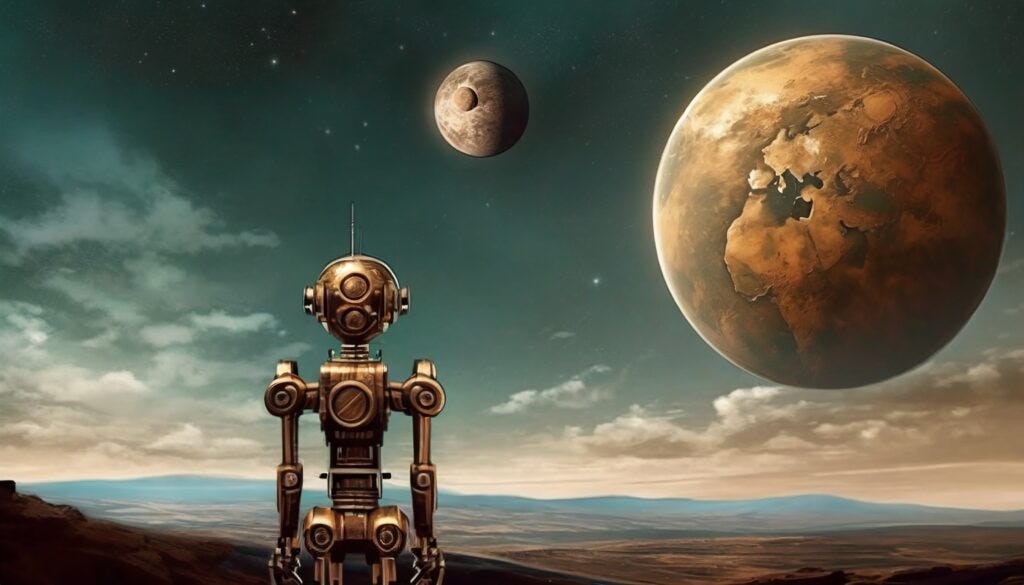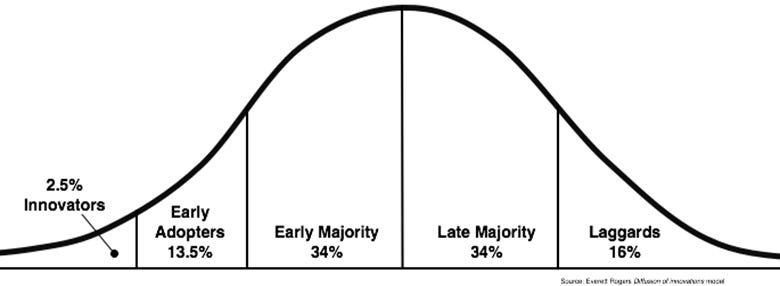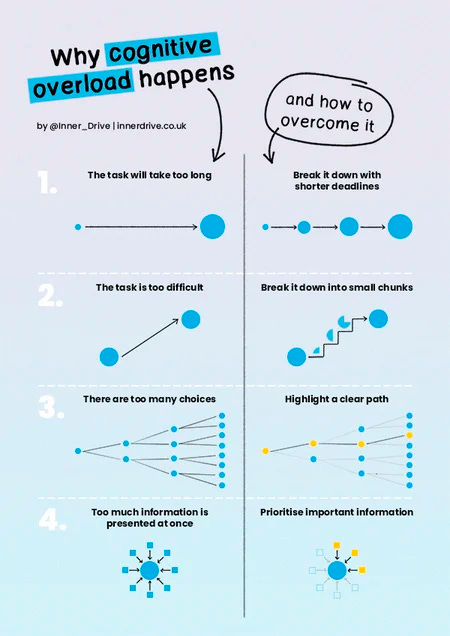Welcome to Recalibrating! My name is Callum (@_wanderloots)
Join me each week as I learn to better life in every way possible, reflecting and recalibrating along the way to keep from getting too lost.
As an aside, I can't believe that this is week 20 since I quit my job as an IP lawyer and patent agent 🤯. While it has been a mix of stress and excitement, I very much appreciate the opportunity to explore this rapidly changing world.
Thanks for sharing the journey with me ✨
This week we are going to talk about the shrinking timelines of innovation and the feeling of being overloaded with information.
You can read this entry online here.
Recap
Last week, we touched on Maslow's Expanded Hierarchy of Needs: Cognitive and Aesthetic needs and what it means to be human in an AI world.
One of the main reasons I started this newsletter is that I foresaw the current disruption that is happening with artificial intelligence. I realized that to look ahead, to predict where the world was headed, I needed to look back at what it meant to be human in the first place.
This week, we are going to continue by discussing the blocks to expanding our humanity and how we can overcome them.
The Bigger Picture of Innovation
As a patent agent and IP lawyer, my job was to talk with inventors about their ideas. We would work together to identify the essence, the core, of what their main idea was. This usually involved me guiding them from what they thought their idea was to where the value in their idea actually lay. I would then take that concept and structure a value packet, a patent, explaining the idea and its value.
Ideas are at the heart of what it means to innovate, to change and develop our society. An idea is something that spreads from person to person, eventually disrupting society at large.
A Brief History of Innovative Ideas
Back in the day, people wrote books by hand. To sell 1000 books, people needed to handwrite 999 copies of that book (with no backspace key or whiteout available to fix mistakes). Accordingly, books were a very valuable resource due to their scarcity (limited supply).
In other words, the time taken from generating the idea to executing (sharing) the idea was extremely long, and for many people, infinite. Most people couldn't even read, let alone get their hands on a book.
In 1440, the printing press changed everything. An invention, an idea, that shook the world.
All of the sudden, books could be rapidly reproduced, drastically increasing the supply and reducing scarcity. The world was flooded with ideas that had previously been trapped between the scarce supply of pages.
The time between idea and execution was shortened.
Almost 500 years later, broadcast television was aired for the first time. While newspapers had been around for a while, a form of sharing ideas and information with the public, the publication of a newsletter was not a real-time occurence. It was asynchronous with the viewer (not at the same time).
Television changed the synchronicity, enabling the airing of information in real-time to anyone who had a TV to receive it.
While the time between the idea and the execution of the idea was removed, there was still a problem. With this type of broadcast, the television had the same issue that newspapers faced: censorship. The information being broadcast had to be run through a network that controlled the information output.
Fast forward almost ~60 years (early 1990s) , we have another invention that disrupted the world even more than television: the Internet. For the first time ever, any individual person could broadcast information to anyone else in the world with an Internet connection.
Everyone could instantaneously execute on their ideas, sharing them with the world. These ideas were mostly limited to blog posts and other written formats.
in 2005, YouTube made public video broadcasts available to everyone.
We have finally reached a stage where the generation of an idea and its publication (execution) to the world is now instantaneous and censorship-proof (in most places in the world).
Diffusion of Innovation
Now, when I refer to the time between the idea and the execution of the idea becoming instantaneous and censorship proof, I am referring to the ability to share the idea with the public. There is another stage after execution: adoption.
The public acceptance (adoption) of the idea can only exist if the public sees the idea in the first place. If they never watch your YouTube video or never read your newsletter, they do not know that your idea exists.
The same concept applies to the broader ecosystem of innovation. There is a diffusion of innovation, a spreading of ideas, moving from the innovators to the laggards, people who take a while to adopt what the innovators embraced right away.
In order for an idea to spread, it must be adopted. Adoption means that a person changes their behaviour, operating in a different manner than they did before the idea impacted their life. There is a recalibration of society 👀
In other words, true innovation requires the adoption of the idea that the innovation is based on in order for the idea to actually spread. We must go from idea to execution to adoption.
In 1962, E.M. Rogers developed the Diffusion of Innovation theory, one of the oldest theories in social science. This theory describes five different stages of innovation adoption:
Innovators: the first people to try the new idea (risk-takers)
Early Adopters: people comfortable with the idea of change (opinion leaders)
Early Majority: people who wait for proof of the idea before embracing it (faster than average)
Late Majority: people who are skeptical of change and wait for the majority to embrace the idea (~the average person)
Laggards: conservative traditionalists ruled by fear of change (pressured to change by the majority)
This curve also represents the relative market share of companies that embrace the innovation over time. In other words, when the late majority gets on board, the market share is already at 50%.
Diffusion of Innovation Is Accelerating
In my opinion, the diffusion of innovation is accelerating rapidly. Innovation itself is happening faster and much more frequently. The time between idea and execution (publication) is non-existent due to the Internet, which is also accelerating the adoption of new technologies and ideas.
This rapid timeline and adoption acceleration is shrinking the time between the generation of the innovative idea and the adoption of the idea by society. We have moved past merely having the ability to broadcast the idea to the world, but actually having the innovators (first adopters) begin to adopt the idea almost instantly.
Historically, it took a long time to get from the innovators to the laggards. It took a while for the idea to spread (an issue overcome by the Internet and social media) and it also took a long time for the bugs in the products to be worked out enough for the laggards to accept the idea.
The innovators were the first adopters, meaning they were also the first people to provide feedback to the inventor. The inventors would take this feedback and iterate on the product, improving where possible as more and more people adopted the innovation.
Part of the reason for this traditionalist and historical delay is that the products were physical. Products had to go through design, supply-chain, manufacturing, and distribution changes to adopt the feedback and iterate the product.
However, many innovations today are software based. They are code. Software does not need to go through the same supply-chain and manufacturing development as physical products. In other words, the time between idea generation, execution, adoption by the innovators, and iteration of the product is drastically reduced.
Additionally, when the innovators adopt the new software, they can provide instantaneous feedback to the developers, meaning that the developers can very quickly update the product to appeal to the early adopters. The early adopters then can provide instantaneous feedback, accelerating the adoption by the first majority, and so on, speeding up the curve.
Once the product has been adopted, upgrades to the product become very simple: push the code out and have the user click update software. Of course, there is a lot of design and coding that goes into the updated product, but the distribution is instantaneous.
The time between idea and mass adoption is shrinking drastically, which also increases the acceleration of the development of new products that innovate on top of the old ones.
The diffusion of innovation process is being accelerated more and more every year, especially with the assistance of artificial intelligence.
I believe the changes coming with AI are going to be more disruptive than almost any (if not all) innovations we have ever experienced throughout human history. The time between idea, execution, and adoption is going to continue to shrink and perhaps disappear entirely (or at least, that's my goal).
Unfortunately, there is a problem here: keeping up with these innovations has become more difficult in a world that is changing faster and faster every day.
We find it hard to keep up with this rate of innovation. Humans were not meant to take in this much information. Each new innovation provides more information we must consume in order to keep up with the rate of change.
We experience information overload. Our brains get overwhelmed, making it hard for us to notice the change, let alone embrace it.
Cognitive Overload
Referring back to last week, as part of Maslow's Hierarchy of Expanded Needs, I discussed the cognitive need. This need relates to our own human knowledge and understanding.
With the rapid acceleration of innovation and the ability to view this innovation in real time (i.e., through social media and the news), we are constantly bombarded with more and more information every day.
The average person receives more information in one day than someone in the 1500's did in their entire lifetime.
This trend is only going to continue accelerating with generative AI. My guess is that it won't take long for the amount of AI generated content to overtake the amount of human generated content on the Internet (if it hasn't already).
The reason is simple, it takes me hours and hours of research to write these newsletters, edit them, select and generate the images, proof-read, publish, and finally promote them. In the time it takes me to write one well-thought out article, AI could have written and published literally thousands of articles.
Now, the quality of those articles is another question, one I won't get into now, but the point is that we are experiencing an influx of information at a scale we've never seen before.
With tools like foundation LLMs (i.e., what powers ChatGPT), we have established a foundation from which new AI apps can be launched in seconds (see GPTBuilder). Bill Gates recently wrote about this in a great article on autonomous AI agents, a topic I have been researching for months.
Accordingly, not only have we have shortened the time between idea and execution of the idea to mere seconds, we are building tools that will autonomously build more digital products than ever before.
These products will be promoted and shared on social media and the Internet at large, generating a large amount of noise (low-quality information).
So what do we do? How can we keep up with the pace of innovation? How do we find the signal in the noise?
How do we prevent ourselves from being overwhelmed by information?
Overcoming Cognitive Overload
The first and most important tool you have to overcoming cognitive overload is, well, your cognition. Your ability to think.
You have been learning your entire life how to develop your thinking skills. From the moment you were born, your brain began taking in information from the world around you, processing that information, and using that information to control the actions in your life.
In today's informationally-overloaded world, understanding how YOU process information is the best tool you have to fight the overload.
The skill of processing your own thinking patterns and recognizing how you uniquely operate is called metacognition (thinking about thinking).
When you come across new information, consider how you are filtering that information.
Perhaps a better question: are you filtering that information?
The more you begin to pay attention to the way your brain works, the more you will begin to understand what type of information overwhelms you and the better you will be able to design systems you can put into place to filter out the noise and retain the signal.
Many people operate on autopilot, scrolling through news apps and social media, taking in whatever information the algorithm throws at them.
Remember, the algorithms are there solely to keep you hooked on whatever platform you are currently on. They do not have your best interests at heart (or at mind).
Taking a step back to look at the source of the information and considering whether that information is needed in this moment is the first step to turning off the autopilot and taking control of your own actions.
Next, consider why you are feeling cognitively overloaded in the first place. The reasons will vary from person to person and information source to information source.
Information vs Knowledge
Another skill is to recognize the difference between information and knowledge.
Information comes from sources external to ourselves. We internalize this information like putting data into a database and tagging it with details on where it came from and what it's related to. Think of filling out an Excel spreadsheet.
The information becomes knowledge when we link it to our existing knowledge bank, tying the threads of information together in our minds by taking the time to understand the subject-matter.
Information overload is quite common, and can be the cause of cognitive overload (in my experience). However, information overload is not the same as knowledge overload.
Knowledge is tied to your existing understanding of the world around you. It's information that has been cultivated over time. Accordingly, it is not the unknown, but the known. The known does not trigger the same prime fear of the unknown as unknown information does.
That is not to say knowledge overload can't happen. I view knowledge overload as analysis paralysis. I have so many nuggets of knowledge competing for action that I end up not taking any action at all. The solution (in my opinion) to knowledge overload is to develop wisdom.
Wisdom is knowledge in action. Taking the knowledge we have forged from information to modify our behaviour, see how that action performed, learn from our mistakes, and move forward with what we have learned. I talk more about this with experiential learning.
Metalearning: Learning to Learn
Learning to learn is the most valuable skill you can ever acquire because it is the skill that lets you learn all other skills.
However, each person learns differently. Only you can know how you like to consume information, convert it to knowledge, and action it through wisdom.
This wisdom comes with practice of reflection, self-awareness, and metacognition.
I will be discussing these topics and how to build your own system with my paid subscribers. A system for reflecting, processing, and metacognitively improving your own thinking by using a second brain, a digital mind.
A second brain is a place for you to offload information and link that information together to form knowledge. It is, in my experience, the best way to deal with information overload and has completely changed my life.
I highly recommend starting to journal and keep track of your thoughts and feelings. The act of journalling, to link my self from day to day, has helped me accumulate a vast amount of knowledge without being overwhelmed. Writing each day has helped me solve some of my greatest problems and helped me work up the courage to quit my job.
Understanding Innovation
Given how rapidly technology is changing each day, having a better understanding of how you learn will help you understand WHAT you should learn.
Follow your intuition, explore topics that interest you for reasons you might not be able to explain.
As AI continues to innovate, we are going to need to fine-tune our own filter of reality so that we can prevent information overload and find the signal through the noise. We need to be able to focus our attention on the innovations that we actually care about.
Recognizing that the diffusion of innovation is going to continue accelerating helps remove some of the FOMO, the fear of missing out, of new products and ideas.
It is better to focus on a few areas that you are truly interested in learning about than letting yourself be swept away by the stream of information that never lets up.
Don't focus on the stream of information. Focus instead on the impact certain information has on you, the moments that resonate in your life. Follow the internal ripples caused by that impact and learn to find the types of impacts that cause waves. Find your flow.
By focusing on the fundamentals of those areas of resonance, you begin to establish a knowledge base, a filtration system for filtering new information as it comes in, drastically reducing the feeling of being overloaded.
You can learn to build on the information that makes it through your filter, connecting information together to forge knowledge and begin building your path to wisdom.
Future-Proofing & Looking Ahead (predictions)
On that note, as I mentioned last week, we are going to enter the age of the AI personal assistant in the near future. This personal assistant is going to be able to help you improve many aspects of your life.
I would list the ways I think it will help, but Bill Gates just did an excellent job summarizing his thoughts on autonomous AI agents (AI that can operate on its own). I recommend reading this article to get a sense on what changes are coming.
Start to consider what you would like in an AI assistant. Imagine a digital magic wand that does whatever you ask of it, or at least, gets you most of the way done. Write emails, summarize research, filter information, brainstorm ideas, plan your travels, etc.
The world is changing faster than ever before. Are you ready?
Next week
This week we touched on cognitive overload as part of satisfying Maslow's Cognitive Needs.
Next week, I'm going to take a deeper look at the aesthetic needs and what I view as creative underload.
Stay tuned ✨
P.S. If you are interested in learning how I build my second brain to help me process information and identify patterns to solve my problems, please consider upgrading your subscription to paid. Your support means more than you know 😌 ✨
If you are not interested in a paid subscription but would like to show your support, please consider buying me a coffee to help keep my energy levels up as I write more ☕️ 📝

















